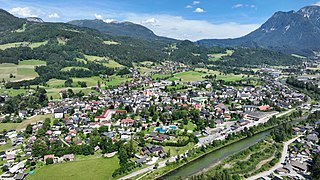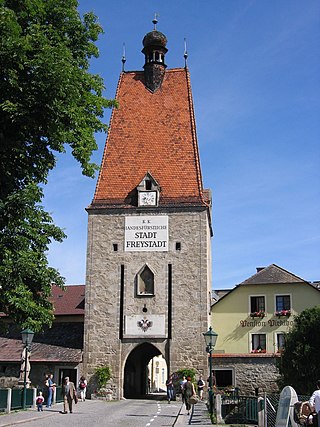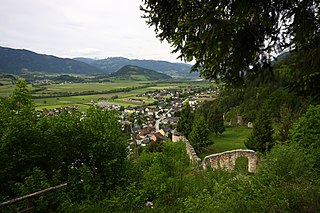
Bad Goisern am Hallstättersee is a market town in the Austrian state of Upper Austria in the district of Gmunden. It is part of the Salzkammergut resort area. At the 2005 census Bad Goisern am Hallstättersee had a population of 7,578 inhabitants.

Mondsee is a town in the Vöcklabruck district in the Austrian state of Upper Austria located on the shore of the lake Mondsee. The town is home to the medieval Mondsee Abbey, whose cloister church was used for the site of the wedding in The Sound of Music.

Auerbach is a town in Upper Austria, Austria. Its length from north to south is 4.3 km and from east to west is 5 km; its area is 10.78 km2. In 2015, it had 565 inhabitants.

Zwettl is a town and district capital of the Austrian state of Lower Austria. It is chiefly known as the location of Zwettl Abbey, first mentioned in October 1139.

Freistadt is a small Austrian town in the state of Upper Austria in the region Mühlviertel. With a population of approximately 7,500 residents, it is a trade centre for local villages. Freistadt is the economic centre of a district of the same name District Freistadt. The nearest sizeable cities are Linz, the capital of Upper Austria, about 40 km in the south, and České Budějovice, the capital of Southern Bohemia, about 60 km in the north.

Regau is a municipality in the Austrian state of Upper Austria near Vöcklabruck, which is the capital of the district.

Oberschützen is a town in the district of Oberwart in the Austrian state of Burgenland.

Burgkirchen is a municipality in the district Braunau am Inn in the Austrian state of Upper Austria.
Mining is a municipality in the district of Braunau am Inn in the Austrian state of Upper Austria.

Moosdorf is a municipality in the district of Braunau am Inn in the region of Innviertel within the Austrian state of Upper Austria. It had a population of 1,684 as at 1 January 2019.

Ostermiething is a municipality in the district of Braunau am Inn in the Austrian state of Upper Austria.

Sandl is a municipality in the district of Freistadt in Upper Austria, Austria.

Gosau is a municipality in the district of Gmunden in Upper Austria, Austria.

Laakirchen is a municipality in the district of Gmunden in the Austrian state of Upper Austria.

Hargelsberg is a municipality in the district Linz-Land in the Austrian state of Upper Austria.

Andorf is a municipality in the district of Schärding in Upper Austria, Austria. As of 2024, it had a population of 5,218.

Zell an der Pram is a town and a municipality in the district of Schärding in the Austrian state of Upper Austria.

Bad Wimsbach-Neydharting is a municipality in the district of Wels-Land in the Austrian state of Upper Austria.

Lafnitz is a municipality in the district of Hartberg-Fürstenfeld in Styria, Austria. It is situated on the upper course of the river Lafnitz.

Wörschach is a municipality in the district of Liezen in the Austrian state of Styria.






















